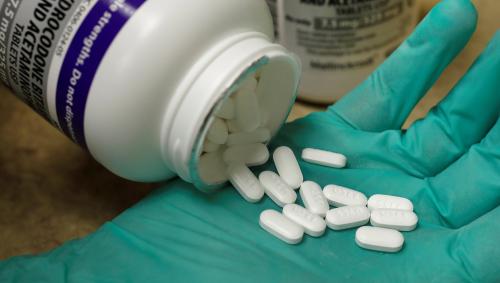Editor’s Note:
This analysis is part of the USC-Brookings Schaeffer Initiative for Health Policy, which is a partnership between the Center for Health Policy at Brookings and the University of Southern California Schaeffer Center for Health Policy & Economics. The Initiative aims to inform the national health care debate with rigorous, evidence-based analysis leading to practical recommendations using the collaborative strengths of USC and Brookings.
This article originally appeared in Health Affairs on November 13, 2017.
When the challenge of affording prescription drugs is raised, pharmaceutical manufacturers often argue that steps to reduce prices will lead to less innovation in the future. This response presumably applies to policies that use the market, such as shortening periods of exclusivity and making approvals of generics more rapid, as well as regulatory tools such as price controls.
The manufacturers’ argument has validity in that expectations of lower revenues will lead to less investment in research and development (R&D). But we question the premise that more innovation is always a good thing. A central tenet of economics is the law of diminishing returns. In this case, additional resources going into innovation inevitably yield fewer important breakthroughs. At some point, perhaps already reached, the yield from additional resources going into R&D no longer justifies what society is paying in the form of higher prices to support this.
Basic Economics Of Patent Protection And Pharmaceutical R&D
Pharmaceutical innovation has produced an enormous amount of social value. The evidence on this point is strong and comes from multiple sources. Studies of disease-specific spending on prescription drugs, macro-comparisons in the United States, and international comparisons have all pointed to high social returns with respect to longevity and functional health outcomes.[1] Those benefits from pharmaceutical innovation stem in great measure from patent policy and the granting of marketing exclusivity to new drug products.
The pharmaceutical industry is what economists call a high-fixed low-cost marginal cost industry. This means that the cost of bringing a new drug to market is very high and the process is risky, while the cost of producing an extra unit of a product that is on the market is frequently “pennies a pill”. There is energetic disagreement about the exact cost of bringing a new drug to market, but there is widespread recognition that the costs run into at least many hundreds of millions of dollars per new drug product.
In addition, for many drugs the costs of imitation are low. It is simple and low cost for a firm that did not develop the drug to produce a copy of a new drug. This means that if free competition were permitted, firms spending hundreds of millions of dollars to bring a new drug to market would be unlikely to recoup those investments, as competition would drive prices down to production costs (“pennies a pill”).
It is these features of the economics of new drug development that make the establishment of intellectual property rights through the patent system and regulation of marketing exclusivity so important to promoting innovation in prescription drugs. Establishing temporary monopoly power for makers of new prescription drug products enables innovator companies to raise prices above the level of production costs and realize economic profits to compensate for the investment in pharmaceutical R&D.
The fact that patents are granted and marketing exclusivity for new drugs is established does not mean there in no competition. Competition between patented drugs that treat the same medical conditions does occur, but it is based on the clinical features of the drugs and to a more limited extent on price. This is referred to as “differentiated” product competition. One feature of such competition is that manufacturers of the products can raise prices above production costs.
In the case of differentiated competition, prescription drug manufacturers will tend to pursue R&D investments where the size of markets and the potential price-cost margins are greatest. Because pharmaceutical manufacturers are uncertain about the investments that their rivals are making and long lead times are generally required to bring a new product to market, there are incentives for rival companies to all chase big markets, for example dementia or prevalent cancers, in the hope of realizing large returns.
The result of this type of “arms race” is “overinvestment” in certain clinical areas and lower rates of return on investment than hoped for. This state of affairs can continue indefinitely, eluding normal market self-correction mechanisms, due to prescription drug insurance that has become more common and more generous (see below) and to public-sector drug programs that are often passive purchasers.
Demand Side Developments
In a market economy, with government acting only to provide patent protection and exclusivity to allow innovation to be viable, drug prices would be set by supply and demand. Since much of the cost of producing drugs involves the research and development to create them—as opposed to the cost of manufacturing the pills—the price that can be obtained influences the amount that is invested in development of new drugs. However on the demand side, higher prices lead to fewer units of the drug being sold. This demand constraint leads to investment being sensitive to value—what a drug accomplishes medically for patients compared to what it will cost. To the degree that health insurance pays for a substantial portion of the price of drugs, manufacturers can charge higher prices and likely will invest more to develop new drugs.
But three important developments in recent years have altered the demand constraint. First, more people have coverage for drugs as a result of the implementation of Medicare Part D and the expansion of insurance coverage under the Affordable Care Act. Second, insurance for drugs has become substantially more comprehensive through the spread of benefit designs that set a maximum on the amount of out-of-pocket spending that the enrollee has to pay.
Third, some newer drugs—especially specialty drugs used to treat complex, chronic conditions like cancer, rheumatoid arthritis, and multiple sclerosis—have very high prices, a factor that impacts demand through its interaction with various elements of the insurance benefit design. If a patient is using a $50 drug and a new, perhaps better medication comes along at a price of $100, insurance benefit designs usually allow the patient (with support from a prescribing physician) to use the newer drug, but at an additional cost. While the difference in cost to the patient is usually less than the price difference between the drugs, only patients who perceive better results will switch.
But this all changes when prices are $100,000 per year or $200,000 per year. For these drugs, most patients who have to pay a substantial part of the cost will not be able to afford the drug at all. However, out-of-pocket maximums make the drugs affordable and in the process make the patient insensitive to price differences. So the $100,000 drug and $200,000 drug cost the patient the same amount—their out-of-pocket maximum. This means that raising prices at this level does not trigger demand restraint on the part of patients.
Thus, the combination of current benefit designs and very expensive drugs means that raising prices even higher may not lead to fewer units. The likely result is higher revenues and more investment in development of new drugs because they promise to be so profitable.
Evidence On Profitability And Innovation
There has been a variety of evidence assembled regarding the relationship between profitability and innovation in the pharmaceutical industry. One major strand of evidence involves natural experiments regarding industry responses to growth in the size of markets.[2] The logic behind this quasi-experimental approach is simple: Larger markets generate greater revenues that in turn create expectations of more profits to manufacturers, which expand investment in new drugs to pursue those profits.
These studies use factors that cause markets for prescription drugs to differ in size, such as demographic changes like aging of the population (Acemeglu and Lin), expansion in insurance coverage (Blume-Kohout and Sood; Dranove, Garthwaite, Hermosilla), and country-disease prevalence differences in market sizes for specific drugs (Dubois, de Mouzon, Scott-Morton, Seabright; Kyle and McGahan) to measure differences and changes in market size. They then examine the innovation response from the industry. Innovation is measured in several different ways. Some studies measure the number of clinical trials, R&D spending or the number of new drugs launched; still others attempt to measure the quality of new drugs launched.
Reviews of the literature on the impact of market size differences on innovation suggest two broad conclusions. First, increases in market size and potential profits have a strong positive impact on innovative activity, whether it is measured by clinical trial activity, R&D spending, or number of new drugs launched. The second conclusion is less unanimous but represents the weight of the evidence: innovation increases less than proportionately with market size.
Together, these conclusions are consistent with a couple of interpretations. One is that the science required to produce new drugs in 2017 is harder than it was a decade or two previously and so the “low hanging fruit” has been picked. A second interpretation, mentioned earlier, is that differentiated competition drives excessive entry and duplication of R&D effort, resulting in overinvestment in certain clinical areas. Both forces can be at work.
A third conclusion has recently emerged but it reflects only one research effort. Using changes in market size stemming from insurance expansion, Dranove and colleagues examined both the number of new drugs brought to market and the degree to which new drugs are “truly innovative,” as measured by being aimed at an under treated illness or being rated by the U.S. Food and Drug Administration (FDA) as high priority. Like prior researchers, they found that as markets grow the number of new products increases; the vast majority of increases occur in markets where there are already five or more products being sold. Dranove and colleagues found no meaningful increases in the number of drugs rated by the FDA as high priority as market size grew.
These latter two results are consistent with a conception of the pharmaceutical market that exhibits differentiated competition and a tendency to overinvest in a limited number of clinical areas. It is important to note that the evidence on this point remains limited and more work is needed. Nevertheless the mix of research findings, alongside the institutional changes in the prescription drug markets, raises fresh questions about the trade-off between high prices and profits on the one hand and innovation on the other.
Looking Forward
Reactions on the part of the pharmaceutical industry to proposals that would lead to lower drug prices, either through market forces (e.g. faster generic approvals) or regulation (e.g. price controls), have emphasized reductions in future innovation. The relationship between prices and innovations is real, but that is only part of the needed analysis. Innovation, like everything else, is constrained by the law of diminishing returns.
Indeed, it is possible that the current magnitude of innovation in pharmaceuticals is already too high in the sense that resources going into it might be better used for infrastructure, education, housing and other priorities. For those concerned about the growing role of government in the economy, since a large portion of higher drug prices are paid either directly (Medicare, Medicaid) or indirectly (tax subsidies for insurance) by government, higher drug prices inevitably lead to either higher taxes or cuts in spending for other priorities.
The authors did not receive financial support from any firm or person for this article or from any firm or person with a financial or political interest in this article. They are currently not an officer, director, or board member of any organization with an interest in this article.
[1] See, for example, Cremieux P-Y, D Jarvinen, G Long, P Merrigan, Pharmaceutical Spending and Health Outcomes, in FA Sloan and CR Hsieh Pharmaceutical Innovation: Incentives, Competition and Cost-Benefit Analysis in International Perspective, Cambridge: Cambridge University press, 2007
[2] See for example Acemoglu and Lin; Blume-Kohout and Sood; Dubois, de Mouzon, Scott-Morton, Seabright; Dranove, Garthwaite, Hermosilla; Kyle and McGahan










Commentary
Pharmaceutical industry profits and research and development
November 17, 2017